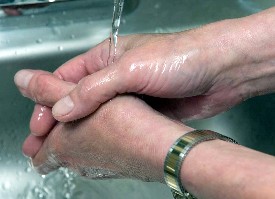Research at University of California at Davis and University of Colorado in Aurora indicates triclosan, an antibacterial chemical used in soap and other personal-care products, hinders muscle contractions in animals, causing weakness in mice and slower swimming ability in fish. The team led by UC Davis veterinary medical professor Isaac Pessah published its findings online in the journal Proceedings of the National Academy of Sciences (paid subscription required).
Triclosan is used as an antibacterial agent in personal care products such as hand soaps, deodorants, mouthwashes, and toothpaste. The chemical is also used as a material preservative in other items around the home including bedding, clothes, carpets, toys, and trash bags, as well as in industrial and commercial products. The U.S. Environmental Protection Agency (EPA) found triclosan in 36 streams in the U.S., where effluent from activated sludge waste water treatment plants, trickle-down filtration, and sewage overflow appear to contribute to the chemical occurring in open water.
The UC Davis and Colorado researchers tested triclosan in the lab on human tissue samples and on animals to gauge its impact on muscle activity, with quantities similar to those that people and animals may be exposed during every day use. In tissue sample tests, triclosan impairs the ability of isolated heart muscle cells and skeletal muscle fibers to contract. Normally, experiments with electrical stimulation of isolated muscle fibers causes those muscles to contract. In the presence of triclosan, however, normal communication between two proteins that control the flow of calcium ions creating muscle contractions is impaired, causing skeletal and cardiac muscle failure.
The researchers found as well that triclosan impairs the ability of heart and skeletal muscles to contract in living animals. Anesthetized mice have up to a 25 percent reduction in heart function within 20 minutes of exposure to the chemical. The tested mice also have an 18 percent reduction in grip strength for up to 60 minutes after being given a single dose of triclosan. Grip strength is a measure of mouse limb strength for testing the effects of drugs and neuromuscular disorders.
Nipavan Chiamvimonvat, a professor of cardiovascular medicine at UC Davis and co-author of the study, noted the drug’s impact on cardiac function. “Although triclosan is not regulated as a drug,” says Chiamvimonvat, “this compound acts like a potent cardiac depressant in our models.”
The UC Davis and Colorado team tested the drug on fathead minnows, a species often used in assessing potential impacts of aquatic pollutants. The minnows exposed to triclosan in the water for seven days have significantly reduced swimming activity compared to controls during both normal swimming and swim tests designed to imitate fish being threatened by a predator.
The authors note that the chemical structure of triclosan resembles other toxic chemicals that persist in the environment, which has led the Food and Drug Administration and the EPA to conduct new risk assessments of the chemical. “We have shown that triclosan potently impairs muscle functions by interfering with signaling between two proteins that are of fundamental importance to life,” says Pessah. “Regulatory agencies should definitely be reconsidering whether it should be allowed in consumer products.”
Read more:
- Bacteria Linked to Indoor Building Water Damage Identified
- Contaminants in City Soil Found Similar to Industrial Sites
- Laundry Vents Emit Hazardous Fumes from Scented Products
- Banned Flame Retardants Found in Pregnant California Women
* * *


 RSS - Posts
RSS - Posts
You must be logged in to post a comment.